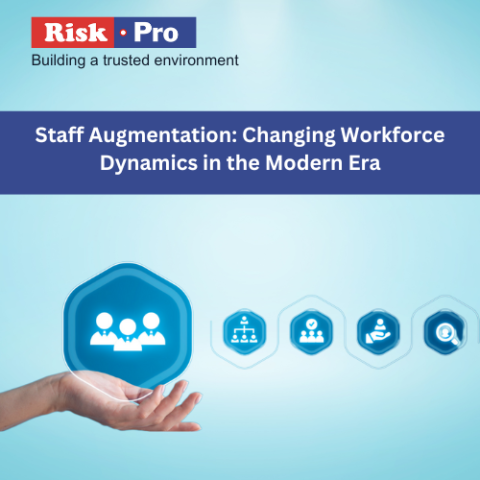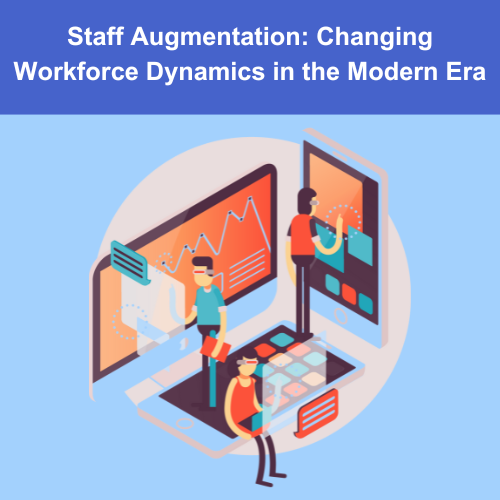
In an ever-changing business environment, firms are continually looking for new methods to remain competitive, adapt to market needs, and promote innovation. Staff augmentation has become a popular method in recent years. This technique, which entails temporarily adding talented individuals to a current staff, has shown to be a flexible and effective alternative for tackling a variety of business difficulties. However, as labour dynamics evolve, so does the concept of staff augmentation. In this blog, we will look at how staff augmentation is evolving, learn about new subjects relevant to this strategy, and analyse its growing importance in today's business world.
Understanding Staff Augmentation
Staff augmentation is a business approach that involves hiring external workers or specialists on a temporary basis to address skill gaps, meet project deadlines, or handle increased workloads. Unlike traditional outsourcing, which transfers entire activities or projects to an external entity, staff augmentation enables businesses to retain control over their processes and internal culture while bringing in specialized capabilities.
This technique is especially common in industries such as information technology, where rapid technical changes necessitate speedy adaptation by firms. However, staff augmentation is not limited to IT; it may be used in a variety of industries, including finance, healthcare, and marketing.
The Changing Field of Staff Augmentation
The staff augmentation landscape is always shifting, driven by technological developments, changing labor dynamics, and an increasing requirement for agility. These are a few of the new ideas influencing how staff augmentation may develop in the future.
- Remote Work and Global Talent Pools: The COVID-19 pandemic has hastened the transition to remote work, breaking down geographical restrictions and increasing access to a worldwide talent pool. Companies are no longer constrained by location when looking to supplement their teams, allowing them to access varied skill sets from all over the world.
- Integration of AI and Automation: As technology advances, staff augmentation is becoming more automated. AI-powered platforms can connect firms with the best personnel based on project objectives, skill sets, and cultural fit, expediting the hiring process and lowering the time required to onboard new team members.
- Project-Based Work Over Full-Time Roles: The gig economy has led to a shift towards project-based labour over traditional full-time positions. Professionals are increasingly demanding flexibility and variety in their professions, making staff augmentation an appealing choice for both employers and employees. This trend is especially common in the technology business, where specialists frequently favor short-term engagements that allow them to work on a variety of projects while constantly updating their abilities.
- Emphasis on Soft Skills and Cultural Fit: Soft skills and cultural fit are becoming more important in staff augmentation, even though technical abilities are still vital. Companies are looking for professionals who can collaborate effectively, adapt to company culture, and contribute positively to team dynamics. This shift reflects a broader recognition that successful project outcomes depend not just on technical expertise but also on interpersonal and communication skills.
- Hybrid Models of Staff Augmentation: The future of staff augmentation is likely to involve hybrid models that combine traditional staffing with project-based outsourcing and remote work. Companies may adopt a blend of full-time employees, augmented staff, and outsourced teams to create a more dynamic and resilient workforce. This hybrid approach allows businesses to maintain continuity and stability while also benefiting from the flexibility and specialized expertise that staff augmentation provides
Staff augmentation V/S Staff outsourcing
Staff augmentation and staff outsourcing are two independent ways for meeting a company's personnel needs, each with its own set of benefits and considerations.
Staff augmentation is the process of temporarily adding competent experts to an in-house team to fill specific shortages or meet project demands. This strategy offers flexibility, allowing businesses to scale up or down their staff based on immediate needs. The increased personnel joins the existing team and reports to the company's management, ensuring more control and alignment with internal processes. It's perfect for firms that need specific talents but don't want to commit to recruiting full-time personnel for the long term.
Staff outsourcing, on the other hand, involves allocating complete functions or projects to an external source. This technique saves money while allowing the internal staff to focus on key company tasks. The outsourcing company typically supervises the workforce and operations while delivering predetermined results. It is appropriate for non-core operations such as IT support and customer service or payroll management, where the outsourced workforce works independently.
Recent trends are influencing these strategies. In terms of staff augmentation, the rise of remote work and gig economy platforms has increased access to global talent pools, allowing businesses to obtain specialized skills more swiftly. Outsourcing is increasingly focusing on strategic partnerships rather than transactional agreements, in which vendors give value beyond cost savings, such as innovation and process improvement.
There is an increasing emphasis in outsourcing on strategic partnerships rather than transactional engagements, in which contractors deliver benefit other than cost savings, such as innovation and process improvements.
Both tactics can be beneficial, but the choice is based on a company's specific requirements, such as the desired amount of control, financial concerns, and the type of the job involved.

Best Practices for Successful Staff Augmentation
To fully realize the benefits of staff augmentation, businesses must take a deliberate strategy.
Below are some suggested practices to consider:
- Clearly define roles and expectations - Before employing augmented staff, it is critical to have a thorough understanding of the duties and responsibilities. Clearly defined job descriptions, expectations, and deliverables will assist guarantee that the firm and increased staff are on the same page from the start.
- Select the Right Partner. - Choosing the correct staffing agency or platform is critical for a successful staff augmentation strategy. Look for partners who have an established track record in your industry, a thorough understanding of your company's needs, and access to a pool of top talent.
- Integrate Augmented Staff into Your Culture. - Although augmented workers may be transitory, it is critical to integrate them into your company culture. This involves giving onboarding workshops, introducing them to important team members, and including them into company-wide messages and activities.
- Leverage Technology - Use technology to improve the management of augmented teams. Project management tools, communication platforms, and performance tracking software can assist guarantee that augmented employees remain productive and engaged, regardless of where they are located.
- Emphasis on Continuous Improvement - Staff augmentation isn't a one-time solution. Review the performance of your enlarged team on a regular basis, as well as the success of your strategy. Seek input from both the increased workforce and your internal team to find areas for improvement and make any necessary changes.
The Future Of Staff Augmentation
The future of staff augmentation looks promising, with the potential to transform the way firms function. As technology advances, new tools and platforms will develop, making it easier for businesses to acquire and incorporate external talent. Artificial intelligence and machine learning are likely to play an important role in connecting businesses with qualified candidates, expediting the recruitment process, and optimizing workforce management.
Furthermore, the concept of staff augmentation is projected to evolve beyond short-term projects. Companies may begin to explore long-term collaborations with external professionals, resulting in a hybrid workforce that combines the permanence of permanent employees with the flexibility of augmented workers.
Conclusion
To summarize, staff augmentation is more than a stopgap solution; it is a deliberate approach to labour management that enables businesses to stay competitive in a continually changing environment. Businesses may create a more flexible, resilient, and competent workforce that is prepared to face tomorrow's challenges by analysing and adjusting to current trends. To know more contact us at info@riskpro.in
